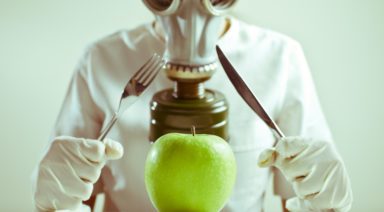10 Gross FDA Regulations the Government Doesn’t Want You to Think About

Taking shortcuts on occasion is understandable, but we really don’t want shortcuts being taken on our food, and especially not by our government that’s supposed to be protecting We the People. Unfortunately, there are 10 dangerous little food shortcuts that have come up recently in a Huffington Post article that may shock and scare you, but really, we shouldn’t be so surprised in an economy that focuses on getting the most bang for your buck at any cost. The good news and bad news is, all of the information is public record, if you have the stomach to dig through it.
1. Mold, Excrement, and Bugs
If you don’t mind getting a little nauseous in uncovering the truth, try reading the FDA’s Defect Levels Handbook and the levels of contaminants your food can contain. It labels it off as “maximum levels of natural or unavoidable defects in foods for human use,” including “insect filth,” “rot” and “Mammalian excreta.” But reading what exactly insect filth can entail (canned or frozen asparagus is permitted to have “10% by count of spears or pieces infested with 6 or more attached asparagus beetle eggs and/or sacs,” and berries are allowed a specific amount of larvae or rodent hairs, yay!) is enough to make you wonder why the hell we’re just letting this happen. Um, can we hold all of the beetle eggs, mammal poop, and rodent hairs, please?
2. Genetic Engineering
According to the Organic Consumers Association, the United States is the only developed country that does not require testing for safety of GE foods. It’s not required, and it hasn’t been done by the government. So all these people decrying the push against GMOs don’t really have a leg to stand on, when the positive or (most likely) negative effects of genetically modified foods have not been proven by our government. GMOs…bon appetite!
3. Ammonia in meat
This practice has been around a long time, very notably, it cropped up in a lot of McDonald’s burgers (they’re really batting a thousand for their healthy choices!). It’s commonly known as the “pink slime” factor on your meat. Ammonia is the FDA’s first choice to kill bacteria in meat. “But wait,” you may say, “is it the same stuff I use to clean my house or that I use in my fertilizer?” Yes. Yes it is. The FDA claims it’s fine because, “it eliminates E. coli to the same degree as if you cooked the product.” You may have internal damage from ingesting it, but at least you won’t have a case of E. coli from your tasty hamburger!
4. Monsanto
Monsanto has been putting forth all kinds of farm products that we aren’t so sure about, such as Round Up Ready Crops and GMOs up the ying. In most recent news, their Round Up Ready herbicide has been labeled as responsible for the eradication of milkweed, the food of the beautiful monarch butterfly, and the following eradication of the butterflies by 81%. So maybe they don’t care as much about butterflies. Do they care about humans? Meet Michael R. Taylor, a guy with his fingers in all kinds of pies. He’s had jobs both at the FDA and Monsanto, one after the other, there and back again. He’s also a heavy advocate for the government’s controversial “revolving door” issue. The FDA’s current Deputy Commissioner of Food is responsible for the substantial equivalence policy, which is used as a weapon against the “right to know” argument for GMO labeling.
5. Arsenic for livestock
Sometimes bad things come in good packages. In September 2013, the FDA stopped allowing a few arsenic-based drugs from being in farm animal feed (it’s been around since the 1940s). The Huffington Post has this to say about it, “While it might seem like a step in the right direction, consider this: The FDA only passed down the decision after food groups threatened to sue the agency. Before the ban, about 70 percent of U.S. poultry were being fed arsenic-based drugs, and even with the new legislation, one of the 4 banned drugs can still be fed to turkeys.”
6. Artificial Coloring
Even when studies are done, the FDA doesn’t do a thing about it. Red #40 (think Doritos and Cheetoes), the most widely-used food dye, and Yellow #6, the third most widely-used food dye, are linked to hyperactivity, migraines and possibly cancer. Europe is, as usual, ahead of the game and has had them banned, but the FDA still isn’t budging to take them off the US market.
7. The “Whole Grain” Myth
We can all agree that whole grain foods are pretty much the healthiest option. We envision untouched grains just full of unaltered vitamins, nutrients, and fiber. But there’s a terrible truth behind what the FDA allows to be called “whole grain.” As long as the naturally occurring nutrients and parts are added back into the food at the end, you can take them out along the way and add in a number of other additives and flavorings. Sigh.
8. The “Trans-Fat” Myth
Once again, the labeling system seems to have fallen through the cracks of the FDA’s radar. When you’re picking through the snack section of the supermarket and find a package with “Zero Trans Fats” slapped across the front, you may want to think twice. If a food contains less than 0.5 grams of trans fats per serving, the label can claim it has “0 grams of trans fats.” Although the FDA recently began a campaign to claim that partially hydrogenated oils are no longer GRAS (generally recognized as safe), legislation has yet to be made against them. If you consume a number of these foods per day, you could be racking up dangerous fats without even knowing. Time to cut back on the chips.
9. Crackdowns on Crime
Would you bust your pals for things they were doing wrong? Probably not, and the FDA is no different. They actually had to be told to prosecute misdemeanor crimes in 2010. A governmental report found the agency to be too soft on corporations that break the rules. Congress found that the FDA’s Office of Criminal Investigations fell short in comparison to similar agencies, in response to which the FDA admitted they were working on “developing meaningful performance measures.” Excuses, excuses.
10. rBGH
Once again, other countries seem to be more on top of things than the United States. rBGH is a hormone that has been banned in more than 25 countries, including Australia, New Zealand, Canada, Japan, and the European Union. Although we consumers have gotten smarter (and tend to pick the products that claim rBGH-free), a 2009 USDA study found that less than 17 percent of cows were being injected with the hormone. The FDA, on the other hand, insists that rBGH (also known as rBST) is both safe and effective.
Scientists Just Inserted a Human Intelligence Gene Into Monkeys

A team of Chinese scientists recently inserted copies of a human gene believed to be associated with intelligence, into the brains of rhesus monkeys in an attempt to narrow the intellectual evolutionary gap. And according to their results, monkeys who were introduced to MCPH1 showed “remarkable” improvements in short-term memory.
The experiment sparked similar ethical concerns as when a Chinese scientist modified the genes of a human baby late last year, using CRISPR technology to give it HIV immunity.
But despite the dreadful image of an ape with near-human sentience, à la Cornelius from Planet of the Apes, the study arouses some interesting relevance to the ancient astronaut theory that humans may have been seeded by an advanced species from elsewhere in the cosmos.





































